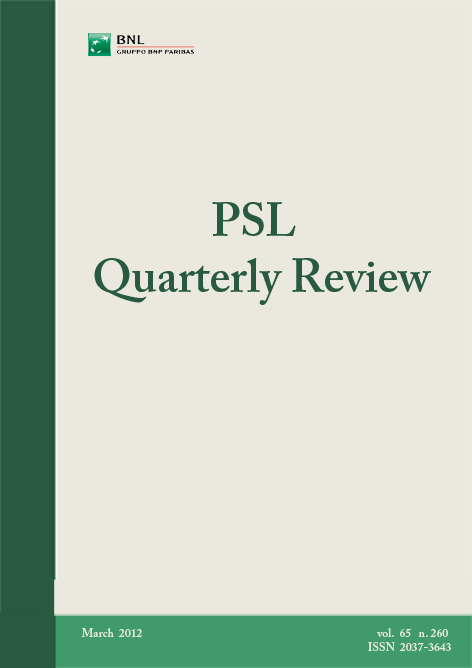Introduction: there is more to Keynesianism than public spending alone
DOI:
https://doi.org/10.13133/2037-3643/9945Keywords:
introduction, Euro, crisis, financial regulation, KeynesianismAbstract
The brief note introduces the articles collected in the present issue of the journal. It places the various contributions in perspective, critically summarizing the major economic developments since the publication of the last issue. After a rapid surge of Keynesianism in the USA and partly in Europe, in the wake of the financial and economic crisis, the cultural and political debate has now already returned to fiercely opposing it. The point is that Keynesianism is often taken in its simplest and "bastard" form, to imply a prescription of large public spending, and indeed ever more spending – with no check, no limit or allowance for a country’s actual financial and economic situation. Once again, the new issue of our journal aims at pointing out how far from reality such caricature is, with some of the articles by self-identified Keynesian writers taking on radically different and significantly more nuanced approaches, as well as how far is it from the economic policy that is needed right now.
JEL Codes: E11, G01, B50, H12
References
BHADURI A. (2011), “Financialization in the Light of Keynesian Theory”, PSL Quarterly Review, vol. 64 n. 256, pp. 7-21.
BRANCACCIO E. (2012), “Current Account Imbalances, the Eurozone Crisis and a Proposal for a ‘European Wage Standard’”, International Journal of Political Economy, vol. 41 n. 1, forthcoming.
D’IPPOLITI C. (2012), “Report on the First Roundtable: a Europe of Growth and Solidarity”, A Renaissance for Europe, Brussels: FEPS – Foundation for European Progressive Studies.
D’IPPOLITI C. and RONCAGLIA A. (2011), “L’Italia: una crisi nella crisi”, Moneta e Credito, vol. 64 n. 255, pp. 189-227.
FERRARI S. (2012), “Crisi internazionale e crisi nazionale”, Moneta e Credito, vol. 65 n. 257, pp. 51-60.
GHOSH J. (2011), “Implications of Regulating Commodity Derivatives Markets in the USA and EU”, PSL Quarterly Review, vol. 64 n. 258, pp. 287-304.
GHOSH J. (2011), “Implicazioni della regolazione dei mercati dei derivati sulle materie prime negli USA e nell’Unione Europea”, Moneta e Credito, vol. 65 n. 256, pp. 297-318.
GIRARDI D. (2012), “Do financial Investors Affect the Price of Wheat?”, PSL Quarterly Review, vol. 65 n. 260, pp. 79-109.
HEIN E. (2012a), “Finance-Dominated Capitalism, Re-Distribution, Household Debt and Financial Fragility in a Kaleckian Distribution and Growth Model”, PSL Quarterly Review, vol. 65 n. 260, pp. 12-51.
KREGEL J. (2011), “Resolving the US Financial Crisis: Politics Dominates Economics in the New Political Economy”, PSL Quarterly Review, vol. 64 n. 256, pp. 23-37.
KREGEL J. (2011), “Uscire dalla crisi finanziaria statunitense: la politica domina l’economia nella Nuova Economia Politica”, Moneta e Credito, vol. 64 n. 253, pp. 15-30.
KREGEL J. (2011), “Will Restricting Proprietary Trading and Stricter Derivatives Regulation Make the US Financial System More Stable?”, PSL Quarterly Review, vol. 64 n. 258, pp. 227-247.
LOPEZ J.L. (2012), “Una riconsiderazione degli studi di Kalecki sull’economia statunitense”, Moneta e Credito, vol. 65 n. 257, pp. 61-83.
MASERA R. (2010), “Reforming Financial Systems After the Crisis: a Comparison of EU and USA”, PSL Quarterly Review, vol. 63 n. 255, pp. 299-362.
MONTANARO E. and TONVERONACHI M. (2011), “A Critical Assessment of the European Approach to Financial Reforms”, PSL Quarterly Review, vol. 64 n. 258, pp. 195- 228.
NICCOLI A. and MARCHIONNE F. (2012), “The Supreme Subprime Myth: the Role of Bad Loans in the 2007-2009 Financial Crisis”, PSL Quarterly Review, vol. 65 n. 260, pp. 53-77.
RONCAGLIA A. (2003), “Energy and Market Power: an Alternative Approach to the Economics of Oil”, Journal of Post Keynesian Economics, vol. 25 n. 4, pp. 641- 659.
RONCAGLIA A. (2011), “Introduction”, PSL Quarterly Review, vol. 64 n. 258, pp. 191-193.
THIRLWALL A.P. (1979), “The Balance of Payments Constraint as an Explanation of International Growth Rate Differences”, Banca Nazionale del Lavoro Quarterly Review, vol. 32 n. 128, pp. 45-53.
THIRLWALL A.P. (2011), “Balance of Payments Constrained Growth Models: History and Overview”, PSL Quarterly Review, vol. 64 n. 255, pp. 307-351.
THIRLWALL A.P. (2011), “Modelli di crescita limitata dalla bilancia dei pagamenti: storia e panoramica”, Moneta e Credito, vol. 64 n. 255, pp. 319-367.
TONVERONACHI M. (2010), “Empowering Supervisors with More Principles and Discretion to Implement Them Will Not Reduce the Dangers of the Prudential Approach to Financial Regulation”, PSL Quarterly Review, vol. 63 n. 255, pp. 363-378.
Downloads
How to Cite
Issue
Section
License



